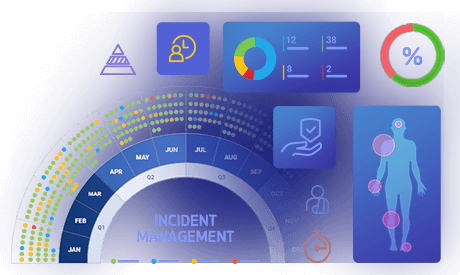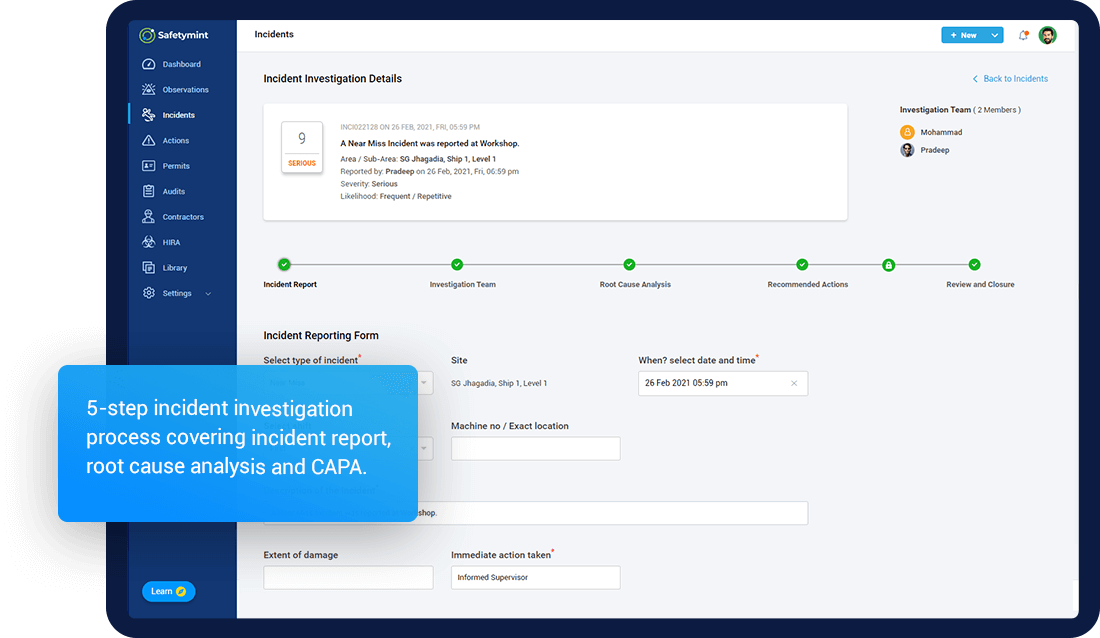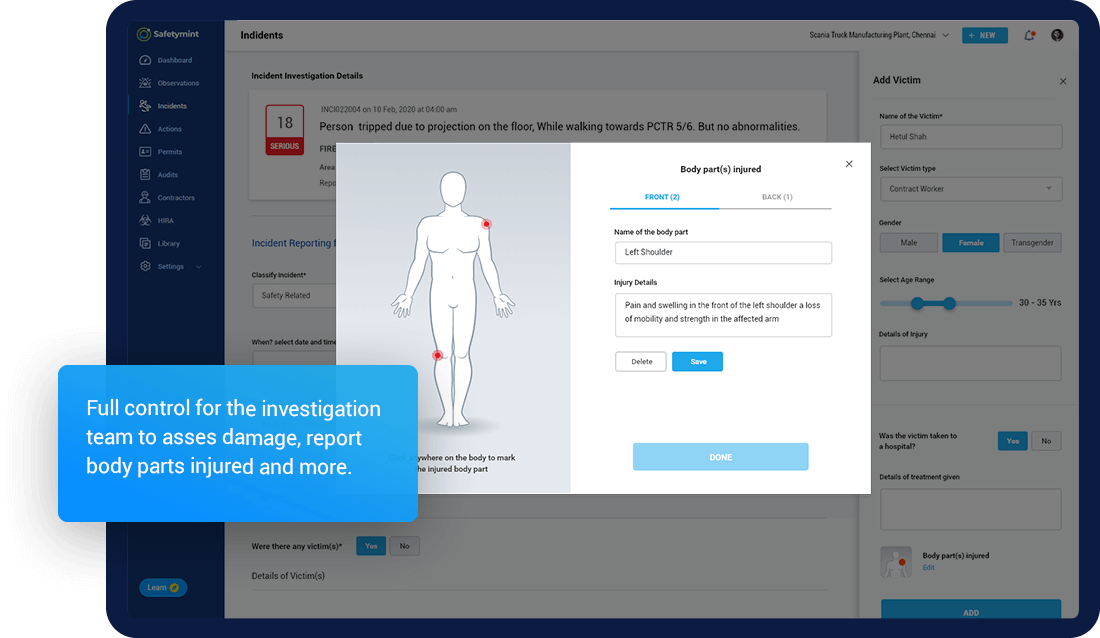In industries with high safety risks, such as construction, manufacturing, or energy, incidents are bound to happen. While they can never be entirely avoided, how you manage them can make all the difference. An Incident Management System (IMS) is designed to handle workplace incidents—whether they're injuries, near misses, or accidents—in the most efficient way possible. It’s like a well-oiled machine that ensures everything is in place, every time an incident occurs.
In this detailed guide on Incident Management, we’ll explore what an IMS is, why it’s important, and how it can help your organization respond more effectively to incidents. You’ll also learn the key features of an IMS, how it benefits businesses, and why it’s essential for maintaining a safe working environment.
What Is an Incident Management System?
An Incident Management System (IMS) is a process or tool used by organizations to log, track, investigate, and resolve incidents. It ensures that workplace accidents, injuries, near misses, and other safety events are managed consistently, efficiently, and in compliance with safety standards.
The system helps organizations respond quickly to incidents, ensuring proper documentation, investigation, and corrective actions are implemented. It also enables teams to identify patterns, track safety trends, and make data-driven decisions to improve workplace safety in the long term.
Here’s what a solid IMS will typically include:
- Incident Logging: Capturing the details of the incident as soon as it happens.
- Investigation and Analysis: Delving into the root cause of the incident and determining how to prevent recurrence.
- Corrective Actions: Implementing steps to eliminate the risks that led to the incident.
- Monitoring and Reporting: Keeping track of incident status and generating reports for safety reviews.
- Clear Communication: Ensuring all team members know their responsibilities and the status of the incident.

Why Should Businesses Use an IMS?
No matter your industry, accidents can happen. Whether you’re dealing with physical injuries, near misses, or property damage, having an Incident Management System helps ensure that every incident is handled professionally and consistently. It provides a centralized place to track every detail of each event, ensuring that your team can take prompt, corrective action.
The advantages of having an IMS include:
- Compliance with Safety Standards: It helps ensure your business stays aligned with local and international safety regulations.
- Prevention of Recurring Incidents: Analyzing incident data allows businesses to take preventative steps and minimize the chance of future incidents.
- Clear Documentation: Keeping accurate records of incidents creates a documented history that can be used for audits, safety reviews, or insurance claims.
- Streamlined Communication: The system keeps everyone in the loop, improving coordination among teams during an incident response.

Key Features of an Incident Management System
To get the most out of your IMS, it’s essential to have these features in place:
1. Incident Reporting: Quick and easy reporting tools to ensure that incidents are logged immediately.
2. Incident Tracking: Real-time tracking of each incident, ensuring that follow-ups are timely and documented.
3. Investigation Workflow: A step-by-step guide to investigating incidents, from collecting evidence to identifying the root cause.
4. Corrective and Preventive Actions: Tools to create and assign tasks to resolve the issue and prevent recurrence.
5. Reporting and Analytics: Automatic generation of reports that track incident frequency, severity, and compliance.
6. Integration with Other Systems: Seamlessly connect with other safety software, such as reporting, training, and risk management tools.
Common Types of Incidents Managed by an IMS
An IMS can handle a wide range of incidents, from minor to severe. Some of the most common incidents include:
- Injuries: Anything from a minor cut to a serious accident.
- Near Misses: Events where an incident almost occurred but was narrowly avoided.
- Damage to Property or Equipment: When tools, machinery, or infrastructure are damaged during work.
- Environmental Incidents: Events that impact the environment, such as spills or leaks.
- Fire or Explosion: Safety events involving fire hazards, which require quick and controlled responses.
Who Is Involved in Managing an IMS?
Incident management doesn’t rest on one person’s shoulders—it requires a team effort. The typical players involved include:
- Incident Reporter: The individual who logs the incident when it happens.
- Safety Officer: The person in charge of overseeing the investigation and ensuring corrective actions are taken.
- Investigator: The team member responsible for understanding the root cause and creating solutions to prevent future incidents.
- Executive Team: Management who review reports and ensure proper resources are allocated for safety improvements.
How Can Software Improve Incident Management?
The right software can revolutionize how you handle incidents. With automated workflows, real-time tracking, and easy reporting, software takes the guesswork out of incident management. It ensures that nothing is missed, tasks are assigned efficiently, and communication is streamlined across all departments.
Here’s how an Incident Management software solution can help:
- Centralizes Incident Data: All incident details are stored in one place for easy access and reference.
- Real-Time Updates: Keep track of incidents as they unfold with automatic notifications and updates.
- Easier Reporting: Generate reports on incident trends, safety metrics, and corrective actions at the click of a button.
- Improved Compliance: Ensure that all incidents are handled in line with industry regulations and standards.

Implementing an Incident Management System
Implementing an Incident Management System in your organization might seem like a daunting task, but with the right approach, it can be a smooth and highly effective transition. The key to successful implementation lies in planning, training, and continuous improvement. Here are the essential steps:
Safetymint Incident Management System
At Safetymint, we understand that managing incidents effectively is crucial to maintaining a safe and productive work environment. That’s why our Incident Management System is designed with simplicity, efficiency, and compliance in mind. Here’s how Safetymint’s IMS can help:
1. Centralized Incident Reporting: Safetymint allows your team to report incidents from anywhere, using a mobile device or desktop. All incidents are logged in a centralized system, ensuring no detail is missed and nothing is lost.
2. Automated Workflows: Our system helps streamline the entire incident management process. From initial reporting to corrective actions, Safetymint automates key tasks, ensuring that nothing falls through the cracks.
3. Real-Time Tracking and Notifications: Stay on top of every incident as it unfolds with real-time updates and alerts. Whether you’re in the office or on the go, you’ll always be informed and able to take the necessary steps immediately.
4. Customizable Reporting: Safetymint’s IMS provides detailed, customizable reports on incidents, corrective actions, and trends. Use these reports to identify areas for improvement and track your safety performance over time.
5. Seamless Integration: Safetymint’s IMS integrates with your existing safety management tools, such as hazard identification, risk assessments, and compliance programs. This ensures that all safety efforts work in harmony to keep your workplace safe.
Table of content:
- What Is an Incident Management System?
- Why Should Businesses Use an IMS?
- Key Features of an IMS
- Common Types of Incidents Managed by an IMS
- Who Is Involved in Managing an IMS?
- How Can Software Improve Incident Management?
- Implementing an Incident Management System
- Safetymint Incident Management System











